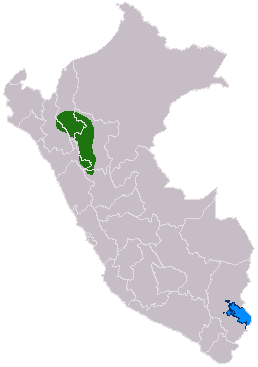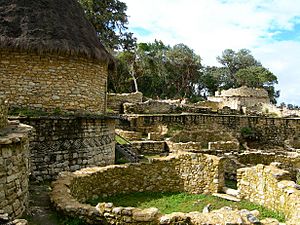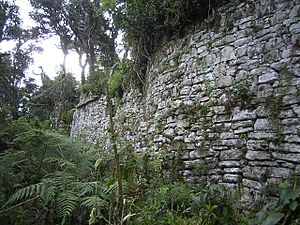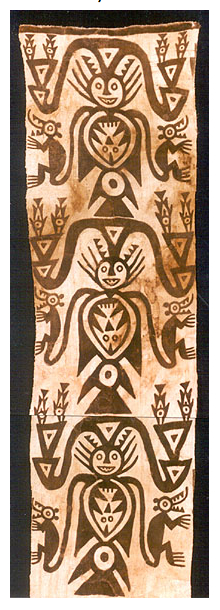Chachapoya culture facts for kids

Map of the Chachapoya culture
|
|
| Geographical range | Amazonas, Peru |
|---|---|
| Period | Late Intermediate |
| Dates | c. 900 - 1470 |
| Preceded by | Wari |
| Followed by | |

The Chachapoyas were an ancient culture from the Andes mountains in what is now northern Peru. They lived in the misty "cloud forests" of the Amazonas Department. People sometimes called them the "Warriors of the Clouds."
The powerful Inca Empire took over the Chachapoyas people not long before Spanish explorers arrived in the 1500s. Even though the Incas ruled them, the Chachapoyas often fought back.
Most of what we know about the Chachapoyas comes from the Incas and the Spanish. There isn't much information directly from the Chachapoyas themselves. Many old writings, like those by Inca Garcilaso de la Vega, were based on stories told by others. Today, archaeologists learn about the Chachapoyas by studying their old ruins, pottery, tombs, and other items they left behind.
By the 1700s, the Chachapoyas population had greatly decreased. However, their unique culture is still a part of the history of the native people of modern Peru.
Contents
What's in a Name?
The name Chachapoyas was given to this culture by the Incas. We don't know what they called themselves.
The name might come from the Quechua words sach'a phuyu. Sach'a means "tree" and phuyu means "cloud." So, it could mean "cloud forest," which describes where they lived. Another idea is that it means "people of the woods" or "forest people."
Where They Lived
The Chachapoyas lived on the eastern side of the Andes mountains in northern Peru. Their land was a triangle-shaped area where the Marañón River and the Utcubamba River meet. This area stretched south to where the Gran Pajáten ruins are found.
The heart of the Chachapoyas culture was the Utcubamba River valley. Because the Marañón River is so big and the mountains are so rugged, their region was quite separate from the coast and other parts of Peru. Still, archaeologists have found signs that the Chachapoyas did interact with other cultures.
The modern Peruvian city of Chachapoyas, Peru gets its name from this ancient culture. The famous Inca writer Garcilaso de la Vega said the Chachapoyas territory was very large. He wrote that it was "fifty by twenty leagues" (a league is about 3 miles), which was big enough to be called a kingdom.
This area is sometimes called the "Amazonian Andes." It's a mountain range covered by thick tropical forest. This region goes from the mountain foothills up to high places where old forests still grow, usually above 3,500 meters (about 11,500 feet). The Chachapoyas culture lived in lands between 2,000 and 3,000 meters (about 6,500 to 9,800 feet) high.
A Look at Their History
Archaeologists have found signs that people lived in the Chachapoyas region very early. For example, at Manachaqui Cave, tools and other items were found that are about 12,000 years old! Later, around 2700 BC, people in Manachaqui started using pottery.
The Chachapoyas culture as we know it today is thought to have really grown and developed around 750 to 800 AD.
They built large centers like the amazing fortress of Kuelap. This huge stone fortress has over 400 buildings inside and massive outer walls that are 60 feet (about 18 meters) tall! Another important site is Gran Pajatén. These strongholds might have helped them defend against the Wari culture, a powerful group that controlled much of the coast and highlands around 800 AD.
Kuélap is sometimes called the 'Machu Picchu of the north.' It doesn't get many visitors because it's in a very remote area. Other important places include Gran Saposoa, Atumpucro, and burial sites like Revash and Laguna de las Momias (Mummy Lake). Experts believe that only about 5% of Chachapoyas sites have been explored by archaeologists.
The Inca Takeover
The Inca Empire conquered the Chachapoyas people in the late 1400s, during the rule of Topa Inca Yupanqui. The Chachapoyas knew the Incas were coming and prepared to fight for at least two years. They were known for their strong resistance.
Later, when Huayna Capac was the Inca ruler, the Chachapoyas rebelled again. They killed many Inca governors and soldiers. Huayna Capac tried to make peace, but the Chachapoyas threatened his messengers. So, he ordered an attack. He crossed the Marañón River on rafts and marched his army towards Cajamarquilla.
However, a group of women, led by a former partner of Huayna Capac's father, came to meet him. They asked for mercy and forgiveness. Huayna Capac agreed to a peace deal. The place where they met was made sacred.
To make sure the Chachapoyas stayed peaceful, the Incas placed soldiers in the region. They also moved some Chachapoyas villagers to other parts of the empire. This system was called mitma, where people were moved to new lands far from their homes.
The Incas also built some structures in Chachapoyas territory, like at Quchapampa, Amazonas.
Even though places like Kuélap were strong, the Chachapoyas settlements might have become less organized after the Wari threat ended. This could have made it easier for the Incas to conquer them around 1475. The defeat was quick, but smaller rebellions continued for many years. The Inca used the mitma system to try and stop these rebellions by moving many Chachapoya people to distant places.
When a civil war broke out within the Inca Empire between brothers Atahualpa and Huáscar, the Chachapoyas were caught in the middle. Many Chachapoyas were forced to join Huáscar's army, and many died. After Atahualpa won, even more Chachapoyas were punished or sent away because they had supported Huáscar.
Because the Incas treated them so harshly, many Chachapoyas decided to help the Spanish explorers when they arrived in Peru. A local leader named Huaman from Quchapampa promised to support the Spanish leader Francisco Pizarro. The Spanish then moved into the area and took whatever riches they could find.
Later, some Chachapoyas joined Manco Inca Yupanqui's rebellion against the Spanish. But Huaman's supporters stayed loyal to the Spanish. By 1547, many Spanish soldiers arrived in the city of Chachapoyas, ending the Chachapoyas' independence. People were moved into towns built in the Spanish style. Sadly, diseases, poverty, and other problems caused the Chachapoyas population to drop by as much as 90% over 200 years after the Spanish arrived.
The Inca site of Choquequirao in southern Peru was partly built by Chachapoya people who had been moved there by the Incas.
What They Looked Like
The Spanish writer Cieza de León wrote that the Chachapoyas were "the whitest and most handsome of all the people that I have seen in Indies." He also said their wives were so beautiful that many became wives of the Incas. He noted they wore woolen clothes and special headbands.
However, no other travelers at the time mentioned the Chachapoyas being unusually "white." Some people have wrongly claimed that this means the Chachapoyas had blond hair or looked European. But the word "white" in those days didn't mean the same thing as a racial group like it does today. Another Spanish writer, Pedro Pizarro, described all native Peruvians as "white."
Scientists have studied the remains of Chachapoyas people. They found that their teeth and other features are like those of other ancient Peruvian native groups, not Europeans. This shows that the Chachapoyas were indeed native people of the Andes.

Experts believe the Chachapoyas culture is more like other Andean cultures than Amazonian ones. People likely moved into the "Amazonian Andes" to find more land for farming. There are many terraces built into the hillsides for growing crops. The old farming lands in the Andes and on the coast were not enough to feed the growing population of ancient Peru.
This idea is sometimes called the "mountainization of the rain forest." This is because the landscape changed as forests were cleared, and the people who moved there brought their Andean culture with them. This happened again later when the Inca Empire expanded into the mountainous area of Vilcabamba, building famous Inca sites like Machu Picchu.
Their Unique Style
The Chachapoyas built circular stone houses and platforms on hillsides. Their walls were sometimes decorated with special symbols. Great examples of their building style are the huge fortress of Kuelap and the ruins of Cerro Olán.
Chachapoyan buildings might date back to the 800s or 900s AD. This building style was still used when the Spanish arrived in the 1500s. After the Incas conquered them, they also added their own building styles, like at the ruins of Quchapampa, Amazonas.
The Chachapoyas had two main ways of burying their dead. One way was to place tall, human-shaped sarcophagi (stone coffins) standing upright in caves high up on cliffs. The other way was to build groups of small, house-like mausoleums inside caves carved into cliffs. These burial styles are similar to those found in other Andean cultures like the Tiwanaku and Wari.
Chachapoyan pottery was not as advanced as that of the Moche or Nazca. Their small pots often had rope-like designs. For clothing, they usually used red colors. A large piece of cloth found at Gran Pajatén was painted with bird figures. The Chachapoyas also painted their walls, as seen in the tunnels of San Antonio. These paintings show people dancing and holding hands.
Archaeological findings suggest that the Chachapoyas society was quite equal, without a clear ruling class like kings or queens. Their buildings don't show the kind of grand architecture you'd expect for powerful leaders.
Chachapoyas in Pop Culture
The Chachapoyas culture is featured in the adventure novel Inca Gold by Clive Cussler.
In the Indiana Jones movies, the "Golden Idol of the Chachapoyans" is a famous artifact seen at the start of the film Raiders of the Lost Ark. Later, Indiana Jones meets the fictional Hovitos tribe, who are said to be modern descendants of the Chachapoyan region. While the temple and idol are made up, the movie mentions a "Temple of the Chachapoyan Warriors" that is 2000 years old.
The Chachapoyas also appear as a group you can play as in the computer game Europa Universalis IV. They even have a special ability called "Warriors of the Clouds."
|
See also
 In Spanish: Cultura chachapoyas para niños
In Spanish: Cultura chachapoyas para niños




